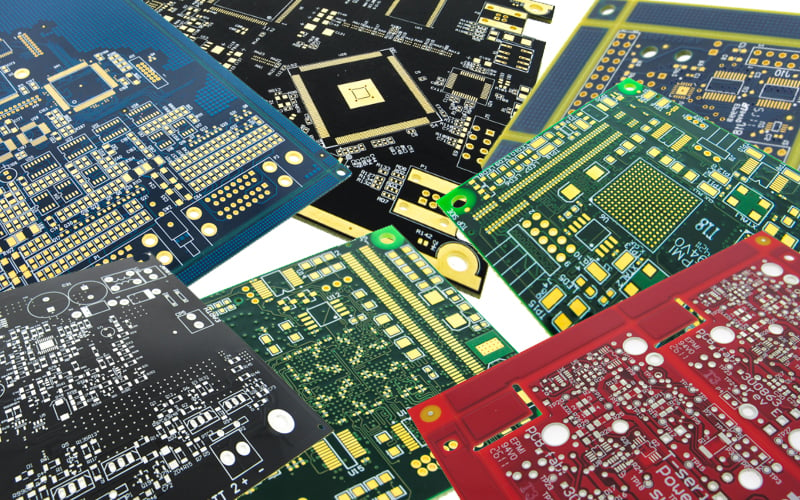Remembering back to grammar school and the standard 8-box of Crayola crayons and when they expanded to 16 or 32 colors, never mind 64. If you managed to get this box with the sharpener, you had it made. I love color; the more the better.
In this blog post, we are going back to that initial 8-box of color crayons and talking about printed circuit board mask standards: what is available and what is best to use.
Solder Mask Colors Available
The original solder mask application was a dry rolled film. The mask was made and supplied cut in lengths to manufacturing. The rolls were heavy and awkward to handle, often hitting the floor while trying to load them onto the lamination equipment. The film was supplied in different mil thicknesses; it had protective clear mylar on the outside and a more saran-type backing to keep the mask from sticking to itself. This mask was the epitome of overpackaging: heavy duty cardboard boxes with dividers, a black plastic UV protected wrapper around the film, and plastic end caps to lift the rolls off the box bed and to prevent flat spots or dents. What a lot of waste!
Green in color with a shine to the finish or a matte finish, it was a difficult product to work with. During the same time-period, a wet mask for the simplest of PCBs was also being used. Single-sided reflow parts were coated with a wet screened application of mask and baked for a hardening finish. This was quick and easy bit due to the liquid for and the print and bake process it was not long lived for the processing of tight pitch printed circuit boards.

Example of printed circuit boards with various solder mask colors.
Introduction of LPI
Liquid Photo Imageable (LPI) soldermask was first introduced in the mid-1980s. I can smell it in the hallway now, and wow, what a stink! It caused headaches for lack of venting and was a sticky mess. It was still a screen process, but it quickly replaced the need for the overpackaged rolls of dry processing Vacrel film.
Initially, the screen process was tack bake, then expose and develop was difficult to manage; timing was everything. The LPI was a gooey mess and everywhere but still a better process than its prior dry film Vacrel application.
Solder Mask Colors
Green Solder Mask
Green was the color of choice by LPI developers and to date is still the most popular color used in masking printed circuit boards. The green LPI has long since been the go-to color by most and because it was the initial color made, it has been tested and proven to work well in most standard production settings. The pigment allows for UV light transmission. Adhering to the surface of the PCB is excellent and can hold a 0.004” web between surface-mount devices. The developing process is excellent as well, leaving crisp, cleared defined edges behind after the solution is rinsed away because this color has been used since the beginning.
Blue and Red Solder Mask
Other colors such as blue or red are the second most popular colors used however being darker. The UV lighting is more difficult to polymerize and adhere to the laminate surface leaving tighter components a challenge to maintain a mask web.
Black Solder Mask
Next is black, the pigment being so dark it is even more difficult for the UV to penetrate and cure this mask. Black can be difficult to process, leaving it challenging for PCBs yield.
White Solder Mask
Finally, white mask is also a challenge because it is reflective. The UV lighting reflects and bounces off the surface, also creating a curing issue.
Clear Solder Mask
Probably one of the least used colors has no color at all and is completely clear. It is the same application with no pigment and has great properties for UV lighting, transparency, and adhering to the surface.
Solder Mask Shelf Life
Because solder mask has a shelf life of 6 months, standard, not all PCB manufacturing facilities carry all colors for this reason, the cost, and the waste is too great to predict. Some colors can be mixed from the standard colors; orange, violet, and yellow can be mixed, however, the science-like paint is not exact, and there could be variance from lot to lot.
As a side note on mask colors, there are also compatibility issues with different surface finishes; the most troublesome is the immersion tin process. There have been reports of a chemical incompatibility between the tin process and blue mask.
What Not to Do
During the PCB design and layout phase, know the color preference you wish to use on the final coat of the circuit boards. Select this color based on the technology level of the part and not on your favorite seen online or on prior parts made. For parts with tightly spaced components <0.009” from copper to copper in component areas, green is the best color to use; green being the initial developed color, the most widely used and tested it is your safest bet. Unlike its former rival the dry mask, the matter or gloss is not as prominent but there is still both available.
Selecting components with mask webbing challenges in mind is a tip to pass on to your teams and remember that gang masking or removal of mask between mounting devices may be necessary to ensure quality product. What is gang masking? The part, cap, resistor, quad-flatpack, IC, whatever component you want to place on the PCB. Each mounting leg or feature has its own pad on the PCB surface to be soldered to. Each pad on the PCB surface ideally will be mask free but surrounded by mask, kind of like an island. The surrounding mask will pool the flux and solder to promote good adhesion while it also prevents shorting during the assembly process. Remember, the minimum web that can be held in most standard processing is 0.004” and the minimum needed to clear the mask from the copper pad is 0.002”. For a minimum of 0.008” copper to copper, we like to have 0.009”.
To gang or not to gang is a tough choice but leaving problematic thin mask between pads is not recommended. When the copper is less than 0.008”, the remaining space is too small to keep the mask between copper features. Ganging or making one large mask relief area for the mounting features is done to prevent issues caused by the mask in assembly. Mask after processing becomes solidified; when mask is undersized to adhere, it can chip and break off the surface and redeposit elsewhere. Flakes of mask in processing solutions is not something anyone wants to deal with so keep gang masking in mind when needed it is the best solution.
Summary
Choosing a solder mask color may not seem like a big deal. It may not even be something you need to consider. However, seeing there are many colors and different brands out there to choose from, knowing the key questions to ask at the design phase will only improve processing, yield, and provide a better product to you.
As always, consult your printed circuit board supplier to review the files with intent to manufacture. The design for manufacturing (DFM) review is a valuable tool and always free at Epec. Our engineering team will review your data package for any manufacturing concerns, data, and layout issues and report findings back to you. Solder mask color related to design is just one item we will point our customers in the right direction to make your selection.
Key Takeaways
- Green Solder Mask Offers the Best Performance for Tight Designs: Green is the most reliable solder mask color due to its excellent UV light transmission, adhesion, and development properties. It’s especially ideal for fine-pitch components and tight copper-to-copper spacing (<0.009").
- Other Colors Can Create Manufacturing Challenges: Colors like red, blue, black, and white present UV curing difficulties due to pigment density or reflectivity, which can impact solder mask adhesion and processing yield, especially on complex PCBs.
- Solder Mask Shelf Life and Color Availability Are Limited: Most solder masks have a 6-month shelf life, so not all PCB manufacturers stock every color due to cost and waste. Custom colors like orange or violet can be mixed but may vary from batch to batch.
- Gang Masking May Be Necessary for Tight Component Spacing: When copper spacing is too tight to hold the minimum 0.004" solder mask web, gang masking (removing the mask between pads entirely) is preferred to prevent flaking and soldering issues during assembly.
- Design Decisions Should Factor in Mask Color Early: Solder mask selection should be based on the technical requirements of the design, not aesthetics. During PCB layout, consider color compatibility and spacing requirements, and always consult your manufacturer during the DFM review.
















